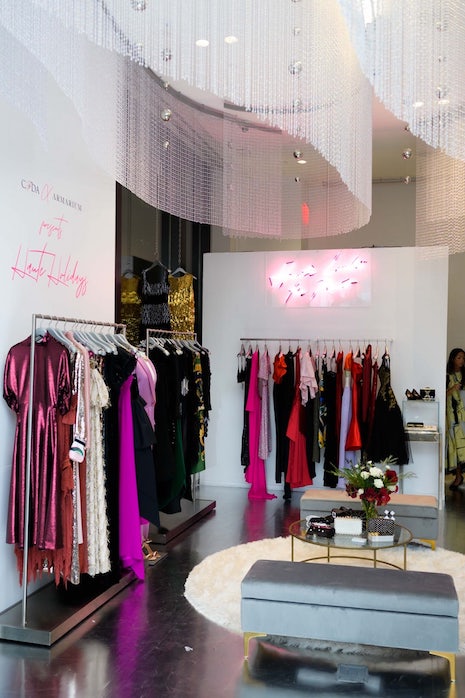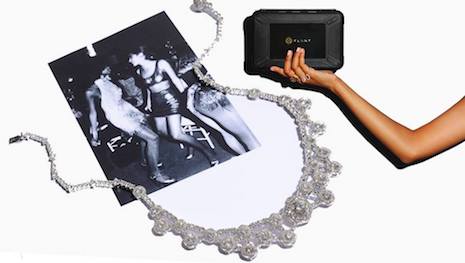NEW YORK – As consumers seek out alternatives to ownership, startups Armarium and Flont are creating a path for brands to introduce themselves to shoppers through rentals.
In a panel at Luxury FirstLook 2019 on Jan. 16, executives from the companies explained how they work with brands to forge a first connection with typically younger consumers through more affordable borrowing services. Allowing consumers to experience a garment or a piece of jewelry in this accessible way often opens the door to a future retail relationship.
“Consumers are shifting their values, opting for joyful and hassle-free experiences over ownership," said Brooke Magnaghi, creative director of Flont. "Many young shoppers are intimidated by the experience of entering a fine jewelry flagship boutique.
"And because of all of this, if we don’t evolve as an industry — the jewelry industry, which is very traditional and generally adverse to change — we risk losing the luxury habit in consumers and the strength of a $70 billion market segment," she said.
Luxury Daily produced Luxury FirstLook: Digital Acceleration
Sharing economy
Armarium launched in 2015 with a series of pop-ups. The service allows consumers to borrow high-end designer fashion, allowing shoppers to experiment with a new brand or get dressed for a special event (see story).
While the company’s primary customer base is the HENRY, or high earner not rich yet, the service has also found an audience with high-net-worth clientele.
Trisha Gregory, the cofounder and CEO of Armarium, explained that this renter is often looking for pieces that are not available in her market or seeking out pieces that were not commercial enough to make it to department stores. Unlike the HENRY, the high-net-worth individual has the means to immediately buy if she falls in love with something she rents.
About 30 percent of customers ask to purchase items after renting them, and Armarium will often send consumers directly to the brands to buy.
In 2019, the service is expanding its bricks-and-mortar presence. After opening at Browns in London last year, Armarium is taking its service to Paris.
This past holiday season, Armarium also popped up at the Cadillac House Retail Lab to help consumers get party ready. Dubbed Haute Holidays, the temporary store stocked pieces from brands including Marc Jacobs, Jason Wu and Thom Browne (see story).

Armarium at Cadillac House. Image credit: CFDA
Similarly to Armarium, jewelry rental service Flont has found an audience with women who want variety.
Since jewelry is a high-touch category, Flont creates a means for women to try before they buy, acting as an “unlimited jewelry box.”
For a tiered monthly fee, renters can borrow a certain dollar amount worth of jewelry at a time. While plans begin at $59, the most popular option is the $379 plan, which allows them to borrow up to $8,000.
During the discussion moderated by Luxury Daily editor in chief Mickey Alam Khan, Flont’s Ms. Magnaghi noted that when women are renting rather than owning, they often gravitate towards more colorful jewelry. However, they will often go on to buy the same item in a more neutral palette.
Last year, Flont entered a joint venture with Hong Kong-based Chow Tai Fook and venture capital firm C Ventures to expand its business in Asia.
Led by Adrian Cheng, executive director of Chow Tai Fook and co-founder of C Ventures, the partnership will give Flont access to a database of 9 million VIPs and a network of luxury properties in Asia. After seeing growth in its home market of the United States, Flont’s joint venture will introduce its services to China, Hong Kong, Macau, Singapore and Taiwan (see story).

Flont lets its members rent jewelry. Image credit: Flont
The company also announced at Luxury FirstLook that it is planning a retailer partnership in the United States. Jewelry stores will list their inventory on Flont, and consumers can search locally available items via a mobile app and pick up rentals at the retailers.
While creating a physical space for Flont, Ms. Magnaghi also sees this as an opportunity for retailers to develop relationships with consumers and drive foot traffic.
New models
Consumers are adjusting their perspective on ownership, leading to the rise of alternatives to traditional purchasing in the fashion and beauty categories.
The convergence of consumers’ thriftiness and desire for sustainability is creating new models for consumption, such as rentals and secondhand marketplaces. In a webinar from Euromonitor, titled "The New Consumerism: Impact on Beauty and Fashion Industries," two of the research firm’s analysts pointed out that brands in these categories need to regroup and deliver experiences and products that consumers are willing to pay for to remain competitive (see story).
Owning luxury items is no longer the only option for consumers looking for the prestige and quality offered by high-end products.
Consumers are now offered the opportunity to rent luxury goods from cars to watches, as the rental market has expanded beyond real estate and offers a taste of the high-life to a wider range of consumers. However, the nature of the sharing economy negates the prestige and timeless intention of luxury goods (see story).
"Retailers have done so much due diligence and surveys in their current customers in how to further service them," Armarium's Ms. Gregory said. "They’re seeking these experiences that they are getting through travel with Airbnb and Uber and they want to apply it to fashion and luxury fashion.
"I’m really excited that everyone’s getting on board and realizing it's not if, it’s when," she said.
{"ct":"Cxjux58e7A33roMQXCqaZzt1kT3QBsEdDEvw2OYJ2XqZE2PH4wDiCq0kkJ6cOcEnx1+bg0InTIN63m0oS\/ggaXgpmSJE5NUtxoNwiLxgW4AdekI7n8cXfrZmdereAy3RETN0rTFBjbI0yjgQRs11ue8aid52yLQwnicmtF7aDr4depYOTWJUEyg+RCcU7QBx\/q3xRS08JNkofmgQ5JxE6H66pSzmnGYDU\/wr+e5Li55DebJl+kXqqmiJN6+HCX3HA2bk0jyG8aaFfLnWLLYMG2izKWRFV+YqXEJ6jF8sceWFVR39\/9\/ZbKtQCzBMjPW\/KVzG\/WfmtfyLBrdbsKiL2jT2Ee1izXNVaLaNqe1pfA77AzshTAzOXGqwdv+2ydHvvpwewqzwl23QYwxzh9eU3iGOJOe+M6sDnsGLQD\/7Ay5+Qdcp\/uqNgCLCKMco6e7rQACbXzqOh8KDUiz2Ov3RvXvUzm0nNkzpAVpM9ctYcYZEcAaO9M7SFJ9pn4r6PMfHtwh5zNDZrhZuP0sje9xOMcockVaNiBeovqrlS2KK0OL6GDgpnKN3PO\/iccYQkhh2Y3lFIoSs3CBbPcTMP3yJ7nalUESXjYFcGNONJZgof1liG2FszST\/JTqZF\/wZgCK2Q34Wss0r+Q6j+rD\/S1whkw6N6hJ8hwZOMquOY0CagocfWNjvxpqv61IaqWAwOp80Lud7y+ne1gA85VlppQLzXUYryNSYG2Y3rZcb\/O4YKjfxK5CqWJed3FnTL\/bc0Rq1urSrmHXTE1BlAN3Cu2ne0BJd2dmQ\/npd13NtR+MAKU4Sl+KiivNKP7qhIY5ZxAYexfpb3cxxgT+uan1pEJ2Yfnh0q1yI\/TwRZCDggeCMZHZY7ZN4HqFmtG7E72gK0dmizfIDdm7oOu6RFeH3J2kGf+9e\/rLZruwmGBVg6XOrMbxFWvo3AABpqikqsxP4mhwNP8I\/l87JoidPubB4Mb5ZAUr+8EARZ1frUotBGj2HRumZcM05CIGPzzPPqF8VsE33qBhU1XmFWcTjEjkC+R3rfQ+2oPR47ewa6jzV7mfDVXVe\/HDXeSJ+kYcucrxSr771swdq8Wa3+YQfqFekFclrfjR0VomsgkzwX2Qo1mqo8vWHgekKRbyupVPQo6kOxK29+6qT3a0A7+isgIInU0IfAhGy2ke5upsJ4fSu6MnMZJWrqwmSLgv1Ht+ifvXnu6\/I2t6NAfMZGSKtfQU+pbyB3XGlH9tSr5OxeKftXksT77xJXQjfpQVE7Qkindqn+\/ZtHtekWGLB6JkOobseJmlnlvBb0DKSQ7l8DknvPYvzeivapuXVgvIhuYlyxfUq1vuQgeDCcY+Pjl6O4p7SafkEwOG6MWO48SEmRmsOm4TfuuvwIk14WlUmLrmU5vTJrW4T3Ps47O2BTFtPUZqYRZH\/TQ7mqirBjuoM3KZ6dmLrODOtAaiLg4VCiDUGbA1DXzihYz4rBdSXxFVOmvuS55nq6taSEqmjhzdhW72Lq2n4hKPUxNRLcwnPUVHubt1Y5XccKG5eZQrcTWFS6iDIZL4lQEaZkNHZA+VYX9NMbZN9jXGwH8Ig0q2Zpr5narQQdrCHCRq8w6d3kOTAGpUXhKdtABV2P+nN6yltxVUSs4okLxSgQJW7eE5NYdTVBuKFJ5kyg3b\/2rEZ51xmurjNeY1gB8\/pBArg8pch5uYWOOz8RStEaoAojWZ0Msizj+1l3\/KjRDDU7pPaQVnL+jeBPkBEVD9JX5xUKOAXplA+u6Z6\/K0oJzaLPZwCH6kwTru68pofhVGYlVUhc9GSrpymfa6P6WrC6ObomAmmv7W\/gWHW0fhdOLhTuG51WPR392hOuxylypua2DxuopHMEYIGpxRgY80LX7iFRU+4+urLvv3rnFEfFcRlj0dRZ6YLRv5Ciq+PG8iDOBORzwX0vkpHB7pjlFfo35Ph\/s8+paV6cJMnFEC+DLj5yOUce5cRjK8Nv1njTE0nApVNJcAC\/hoGZ3wJJThBg3A3N7LHnfcIBdOIRfhuzIAWQ2ou9P67QVjH8K08RhaerVGLinrbYxi\/wSY7YJkPjvXOqLFHn4IwHPGq68vXNiq69go2qpnFOyhfDIoCKTuSLMEr7cRVt9FVY\/28GTfPSkJNFuGcOKywTKaKSRXU+\/PDs92Uo6VibkXQinofGcT2sZuxbs2Pn882wJ4u0wrKE2Nang\/BCtSnfDq9LXIbRZcfG+k0qp2fwE95n1sqC+fWMVtnFhw4u4IoiFp0lT7TEJdXVLee9kg8kgpP2qFc8Tgb3CgkvWk5bygvCkGF9ZUzaGJOn85yc\/WxpoeOWZ+6UJkxFyJ3cjJ3rHF4H2PBn\/a\/bVFR3EKgzzM8bhDKwYcGLTohcfXcdvLJd6Z1ivdZKd+m1mpwjlmU4KTZl2P2vjEGVYRz5BEl1Rrv+mSOLl+33\/zFtx039w+wAwRqhpicI4sRbke+CWvXiNKLE4zcdjvK4eRVnOcVXeqRSs7WS9f9Lcs4bpoLok4Zwu56rZUEh9lpEhmqnWyXQoWQ7YvStnIRw8T01\/zkaUa46lChptSiRwv1uu98PpyNi4VOimh2ijBo3Ad\/qEg077\/gXA9tLK22Awgc0n75qy6YgFOWix9oU3EeplnbhZhW03xSpRmkOATncq69w6I98Y4Gzi+Ic2iuW9nor20aC\/2Sn3mnavpQOgZ1vJa5zoA2fBgrd+7PGTJlzcxn+WUXCoFYnKXd\/iNOeXytjnQwCoYHL67bMLxC7NhUOUTak6GOz5kJElXmREIM9gf+AXXdkC4M9NhI00DKyG7HFMcbT6a44x18fDmsgJ84hOqENxDDw+ULBE4nzmnprEmvs2i7OZGurhOFfbmuTFdmyYomX2W\/jSNri\/oKd0GhzV1ZuftAvCisJtWYGmHAzf0ZfgYqHLea\/6NqbBSsYy3bHBL48rDsG\/HKrNzfW4ZoHCTIQSpqXYrY4G\/t9g4ns9ru30i5KEth+bpl++h18rqLhWlv+Rjiq3WeIaf1ke8nr0VpDjG3+VIY\/UV7vwhIDf9rpXq6GTin0X3lyAEGWZjCTV+wxkgunI6LkMDV93llTzU0wXUdhypmOSxliS813b186jCVr30pcC4TpOQ8CyTFI4qC1\/XdyZNHeiEdy9CKJrx+B7AJxekHdWX3Bm18nhdQrbfJwqEurrmz9ht0OBrbo53m\/tE1\/QHb4xMmRKzoXCta7sQscSzG3q1HggOTYz2DfGeR6gNJiMYd1K\/je9jgpj37Lwmkf22POr1HJy4atg4eCZlXhrBVxUzVhT1bWUqo6+6iH6OBizAOf2yQdGDEm8xwng\/GmYJOPPbxX5qmrsioUFHQrjJ8VLTaZ2rZMYNOCbyjFFpbzgoozKNowA8HhFu1R85sh94hMk6j+WCMzQOhiKjjl8fYSRf4B8vtuUPg0HbqWVGATkmW\/k0lyZALF+GIL0K14CjsSLUf9doJ4aRdiRFMn5nWmjR8aONk9vRkScKmfShA3v5jCIJdqh2cETN\/wGJTDleqbGaGBZL7AMET5MjdjaNYgFwr3nvjJ6aTiqfo\/ZuUczHaMsUAhMHC7ngwKvWoSDgVniNW++v3hoL60edCpamizHUIePcYALGczUvczNki3MJ9q40PjO9KITqcJ64qQsgFTVZu314tirH1wkOoVRa71ub4tbYq6nBayEJ5+zwTvpFko8jxSug+770X\/n\/1v0KiZx98Q00pvgC\/9dSUfGX\/VMHrwzreWou4XtHHcf\/xZ2wXWxGhkBLyAgxkcCUgwDCO2\/aC6VpNJyOIG0TcZ6fFjbYnfE74YHfmwSacO59fqWTLm6VyyB+eMVZu8WMQmOS2qFe8xx2n\/HQojFg0vzuXDcaUfwe8xzkNNa7KJUgmSYvnCO7T+sRft9y1R3oqODE6M\/AaDOkm6QnsL4M4Tv+F2F5AVRwYL4LTnVUw1GxTMTAg9ViEqIlh4yBGKxNiXMnvBx1jkYM6Swx2YSOqcD1+NfgBOri7w55TQatK395zJ8AZSlhBj1IaCBmWEiVbePOOJCqK4D48Ixo9uLjS47uW6Uov\/wj8E6J5DHoCLOWh28nlBJdWhE8ugV+3MQelWjboXRamGmEoS4d\/nGJbz8\/6WS8CieAEXYlUxV92O4NcFnfI7C98u0RgHV9Z26aDmDpfXqqD4\/tPXwPkkKVY8leEx18cJAB2EVZph1DcTyMdfF2tjkz5X\/yjCsITgWMWr0NIqREaWA0x6hFkY0sQvtapf054cs6JEcTbB\/m+0aYQl6eNLpUW+U5wRnHwlLKyehaWf0AMbVNKn5PQoBygPzHRqUO9z9IYPjPjPvgxQf+jwS9BvBQKJsAznui0RikmBe3o4T\/ZpF9iNW41XvrFHCfzifg0ya7IEGGxiTToQNZb9GdaFDbuDpyTG9b+RGra0TlhzDkF7cDp6pHNFo\/ZONzvPyKSJ6\/\/xWEuzShP6OMLsBxEYoCVjJN+\/8cn\/1dCKcqWokY1BoB\/SCh6c9b2pzdzB7IgNL1myv+jCAZZ5h6RkiG8GnLdH9XTYscLsP17Sv3KJ5xCadK9HES4yLSL6Gl+9L\/GfOuu57JzaCTibpcIuUTSPPjopBRA6dDVGcSb97NIVm\/f43lydJkbkJlclUe6XTIMRQqI3sn04HpmDJInxb8TaohdLFlljKVQWkKiWzbj35BeJq5iiwpsOPLcDtOcfY7sNwHpWnSWkRHdlZu7G4EszuhlfDq1hZAEtYVbrKAzEBJ3EbDnhoS\/onoN7JBYSqpy8LmTYslkcGYrtaWIVl1CdwLbHhbXltDKIM+AYvZmaLTsJEAKab1BYPUTDiSCdzNf5dm2o9ZKIkA4QBf+E1mS5s7t9JfPtVvSGDLxlx+Y9zyeKihZjKJixKBLNreflPgXKHiBxUm1CmH97ik5qilBwqWYDOQg7afuIeYv\/wra9ZEyj1r20jXYto9LQQC0P\/aY6vbvBMkjskgflID7wLedQJG3Ua1iRL2btOa1D4NFRujO86dSf5RRG8aL4\/sSw2aycZtsKQ9HnLQIaxaY0k+RuWRuzORgf3Hb7YLOq8NON54jGfjA93oGtII6HoWG1Fgwp1I293sh2yi6LBn9WJkOkxqUlEpOSUdQw6AXoxzv9L3GBlDr6iLfcvGalJ+q5f6rhfL\/A8mHi7HJEHdQgOeku2s59ArwF0KdYOy8JHOC+um16Ey+CdMUKHFKw0cSvCnzAw5oRuGyGclTguOnoi5liHt8164+XNRTTYNfUcgADjbNy2Q8tyediwPirssNrP98SngzV7OVhQMOjunJVk5NwKhsAv+nzpEDoamJ79Z5Ulkl3Hj6RbMwTwwK0W46pDIspaei\/rExZ6Z9uX4vgrzUNQGRrgkHe9WnA4pcuf+liEV10XefXcvSAxvU2H4h\/Gz4IGPQPfhpSOwOtMjLWiQRO8tXAKblzzbxKixnkf0Dm79Cf27+VCEFmqntU49ot26Zhrth6ez5w0wfxDanrFSfbvVA7SpdtPvH3H3dESOcVrL501gflg03UM98IH4KeipKPMl\/iPB+J2AGPQ2U25qCFzxC\/4g1GT54Hg8QtvIuHkgX6IAW25Ray3Bz1pr4m73gsd7No0tiXyFUqhqfE744XIEzjVf4tuve4tHMp\/Q5zuCxxcYyMR1z9ALSjKuccTQejOJYoM\/Xzp7Yz4yltMlcOMABxSobapyAwfuqoPVUKXrM9H28VeEOOY6zAPdE0Vy6XZtdRNk8FEGzNqsIgvK38hoU1u7W9GRSmpyaeo9F3P3FeXBv3SLC7vYOaNZUFTRGxiDWioO1RlE40l0GHn3HZ9B5CKwUxAKy\/Wyy+2\/JDdn+cEQDU1XayVT+nYARf\/x4C2jDEUVfXYgbObL4YRDIoNepY7zG0bdcE0kJAqwdOnYQGXoTxGqZ7VOsMAv0nzmMYfjPgL4dQzvpZNmj2eF5avwmDBhmVLKMhd3iqxCMAZmKELcdJ7aGnDgfhNP25YnPNklP5umEfSJb+eYHL2utEn9A7rDkxl2zbM64v8VG+YLYoiV7XiNRxKVtDwO3hsISTcQ1IDxkKXCqWNJJCbWB\/mNpInLDL1HqjU7Qt1MaJBjo5QkU3GJlCBvQ384yRlNBQ49tPzQviu76IqIzXPz\/VfNiSQ1emKxVpfrQGWJFhyYbtl+B9QMsuai\/ymWByiUKVYbryXwOKE2VbZU+qGRa9WARa4qDqyvhffVtZzQ6JZfNOC\/HzEMccjS3y8RwGq6GchWiUIW20wnp16zjcc5gJOe0mYOYwRnLCqsgxNLEOJANQUafhA7cHzP9XNaXsfAnNL\/Khsi5cTflxHth3+Vpp21j0arvt5CB2IiMp8MM9\/ZLFM4j4oDfPqOS+Ec9cbYhQfb0QlkJTA82hZEO0HHjUMEWoR5e3KsWh8pCtuRb\/qwmb01GJF3Ho6ibfyu+LjNN7n4Zex4vYMX+o0rS6brl4VC3EHCLFHdNQv9sUMN4rCXBgxV7tXPNcUj5mQy40\/daJcey9aG4sbGzx+yfj9ORRLoc8Umpm\/aWnn7gW0L0C47QN16INMarEEiPoaP9lacnPt2YAOgVs64KQd\/R0EqOUmySeLFH\/DKdXOxsn\/+C8dQwzaXp92x3ZDdZ5vwnkrAeQdnR1M7KLu7wht3BW3dc3w\/IIUeUL+wNgMVVTJ6OHlC17r7XPE+y2Tu68xXduO\/iB+A8C5trsZV5kQjtDk8oNSoSgYWfrW1PkWS5jtaSAXTtkBx1WmS5MjV1y0\/wmyg4VLAmLB1g0jg8LodSsKNlXvZdXOpmpiQE32UQEH4MlsAv+03RQeDwz2sJDpS\/7GIqOhc01X9wbM4+brCWMY6IJ6vpsnw+pLtc3LEzMSSWpMf5xM7naFvO9Y1lBhbJdtCwltGmOw9U1gCm4e5Hs9vQrtw3pgDIFmwtq8rP+pL8l0QlCc0DIP\/cyiDyukuPdtBJtduOLamsg1YubHvF\/Bs83GCWQEWYh+g3iBvIdOt1+2wUndN5dUb\/CDpIkDxB8z\/iyWuIopNkLQ4Plr\/IFXhL1EiIjVnU4RHbcTuhrWsLdhVDLjE+1RrRs7mLLGeVo03sr1QWAUuKVywHuEfwHSdd1GhcUBakiOifk2ddK\/7GKusxsRi2A5AKHgC0m+7pyOOCF5DS4r+CjKbKGcmPI4tW2QVJf4vK417mxAW+dy6exaEo4abKSvhhQFjsIyHsk3KlUE6bueYpgTRB5sILw+ITAXhELlB+RFMleukT0tJtXJwECATIxcP0HReeW4xkAM5QOVTUbsrJkwy7Vr5ZPulgy8PJ82xItlpRnbYzEUTkTCPm2FmAj8xLH81tY\/m1IIPcI7EWwob99zICiXSnwEL1QC\/SaVY64cNLd++5TBcAFzzAEJKpca13+vwwnesdviPR92uPiMvKSLRGLMMrSJvrcWJm5AOYdLqooEJzp7Fupp65jV5\/udLmLH6afhgxfdZViTZhaWE1ufReHOrcRSfBjYu5xL6oxG8B8j2xHi2LWwTbWps8cUA\/bVzrG9hw15thzEkADhR06QUhUBKWDdfY9Vuu6vzxMPltYhtiegQeWSUi06tKn0ATwXopP5\/bfa7zhfQaP5XkiXqiOR9PalCKx7Emhn\/X+h8Prd2j12a5E3SE+109MOA51BD5sJjd6fmGt3uyR7ljnQvcyJCm+m3ytPQM93gjHaavXOWnddDxO\/THd5d1y9OYtjr+ynVlN9FMKXrnlQu6oMu\/m8CAi5svJd0iti4eZm1AC53pIqb5NsoNh3vbb5oetGewobqGgDzXp5Su2YWlCSQtOfDIzMORT5eWHQbDUUBarq4lsmYcuPJggNH\/e7tQpiDkK6BY8kB4qr1I8vAkxFNIUbslT+kE74ekkdiSU4tqtbkuqcghwEqzTHf1EpLHjjy5aVKhr4gIG8INw6jFhREt8ysJ5bAugwDZd46EjgBHYFn+7LdV5VK25t+ABtZa3Cpn2Yd8ecmH3lJVaSbYKXZnxouXqsBhgQkNb4zghvq\/a\/3o1uh9Mvi1M3ZJddXGvTvl+YZ66qFRIpT+YsiuwzUYbQ25+IUV3xLbLpW83PuXrFzDeSXaBCic3C0ejHVZ49Bue0Eo9Iider695T6PR6hm7XKbgsdN\/DcHlyUT58\/bkp\/hQRPTUuuQuOyfqDcocHf\/EXp1ym6lU\/eHd6cG73+vwVTxprjAe0B5eAfr3GAXspGo6T8MNVm5Gpw0ZmDZsq1BYVG\/5ebKH4rP3eQF8\/ieZ0\/Lm1Eg9ZqvLdQ5IYgbQDZlbKDzUmdaqfRkY5knMpd0FVG1cmz+2v5Px889yIDFochKHiXnfRbGO9e6BJUgp47YCnTt6P\/Q0XccFvrJuYS1UmCWQufavsTdbwVqrL4ZnDEcwFpT4roLphYIqtljsKpVn0zPw5LQKvWLyokz+C2ildsYevKz0S9BzKmqNX7W2PrhoN1vbNUe8z7hYUMTXcFEfpleilKLWcmZ57U\/l6oYpA7a70CrjAQLUPzaJqALcNgQZDL2BJwKzP1v4GHjnKKWv4LmrdUAMXe9jZWnxmB7z8M3O2cNqCvTjif9TRk0cf7IBGrHVduywbLBlEXR0HxZeDOdVHeN9QH80PxjYpgXHwXxYDa+bKF+M3eYSRxbNWIogIc3qnySPqn1ZWpNbXzRobWR2TIef7f5W3TiQwJvFHobz\/TC9vjaW0YcxLAxkb004TSkO6Juhhiu12PMe5l+I4CphWFXBBKXTZ5PLpl37Sy0cgMGM4PIWqdBG6HZ6zAAz8jkHDu45sNHP0GoRhC2rPH00\/m64zqm+gViDmbyLgtZOaulRVvsfJ2+ZR6mIPykly43VcfdICH6t2fPXcpMmiNrzwP5NWFxDPKi7Re\/1oRMLYlQ9O4CwcE4poxRPIUhpepbF5ETbbIf\/zh867yHnC1LlU9byo5Cjm43U86w7McyY+JKf5v+xH5OkaqiE3kEPFkRVZJkd214kwKL17Isrts3bJrlCGC1uI5yz98lZJ4W\/IpfHbQ0VYZ2sFGk8otVRQQeNPiXfrNsm8yBEKzuxuokHiI7D7bOK++d\/nmlONPAlNRGOPHid9DRSRztQ\/NFKhkek8GjE3yohw0nf4oX5P3lGIpezvAsS0LhfN0aPX6lU067mDgKkmIbiFZdeWA9eiAy3bGAWiUtY5klGH7Re27+\/8buuIjIoOqT57xh6XQLMbWhpjfQRVd2KUB1kY\/S\/9OMSHe3rDfIFgoF5BQeBOfMuD6VYA\/akBhvs1ySFKLqisAbMLImuyam1pGPMseIAI+hsAU61Dk+JeAFEfHa\/aH880QwYCQuNVcwuqNSQNBM956opW+0zGxw8gDoD9ytzDhc7WzaRLsioLRSsL68+Cl8kp6y\/NWNMh4ouPx+R1iK32BLbxGN73YsyV8BkIp8ZGce30\/5qUlN7RBwacOLCCEC\/xsJEhCmjdhckUPmuLGnLMQNgeDUJnHXJTgjhQgG7AAN8HuIexIcOHj97oS2xPh4nAxKRys\/6bFyo3oShPt8SQXU9v33eP0jr8PUYdRjvbE6XhS\/bRDAUyCQqw\/4+467TWE3ow8jkmSh7IvoonWafkfJRZof19WZQwjWiO0pa7RlBsWrAr9tXC+eXMKruuAHNkH1JzhjBz+Op29CLGdBNFDLJsEU5RosW5YsR50YFPCB6MKo\/QBi2Pd\/Jaj9EaBsZTPivIn2R2dD\/LAXEKnFxBZ5z0RUzn74pO5rGu+BMAhf8mGRhY2Tb7NGEQ1YPvXZ37WmWeL6NDj5K\/8W2Tr7iHxLO+V8AdDBXGmN6equJH+HqI6Pw0ddfFJKmDYMb9o8Zw7YiJVj9q0fDDrMVQmSvyFuUnxsZhZocSOtnmiKJdOcg8\/wBQiVIBDHccjUAJs+73\/MwbjwwcduTCjDApAU4F1c+9z3xCCOm7Cb8omYxRpxwicGc+cLCUf5jYJPFLCnXPG+56m3JZfXBeBCx0b3DhpgOU1\/noOvxnN\/Mt3PaLfAT2Vi8JPgMmLaiRWx2FC2TCHYvb\/mFSeFU1oZICMx9A==","iv":"7abfad23323b364f03ccf145d436e252","s":"c2540f4cf970f53f"}

 The sharing economy has come to luxury. Image courtesy of Armarium
The sharing economy has come to luxury. Image courtesy of Armarium